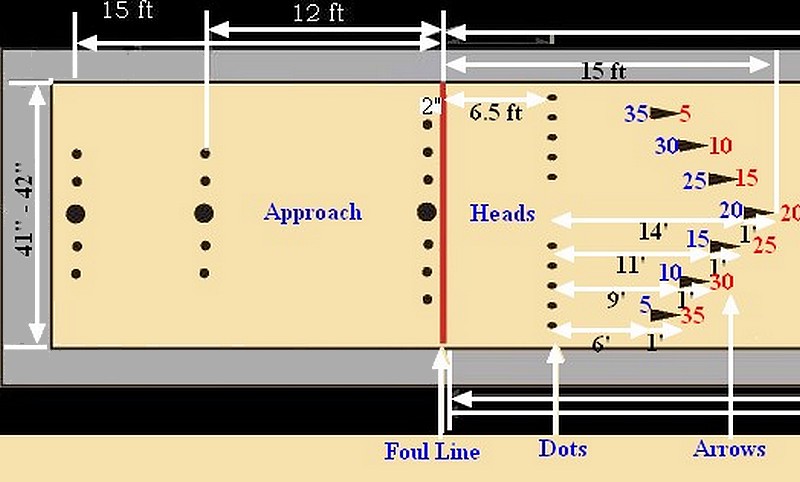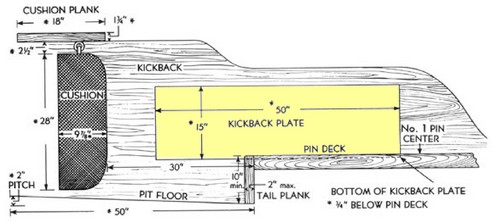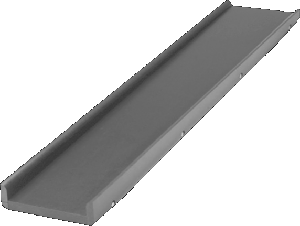What is bowling?
Bowling is a sport played by rolling a bowling ball on a flat wooden or synthetic surface which has portions of the surface covered with an oil or lane conditioner applied in different patterns. The surface on which a bowling ball is rolled, is called the bowling lane, or lane for short. The objective is for the bowler to roll a bowling ball down the lane, and knock down standing bowling pins at the end area of the lane.
Visit each section with a click to open or close
What are all the marks on the lane?

There are a number of areas on the lane, and each has markings called dots, arrows and range indicators placed on specific locations. These markings aid the bowler as they line up and deliver the bowling ball toward the pins in order to achieve the objective of knocking down whatever pins are standing. Bowlers rely on those lane markings, so it is important to familiarize yourself with these tools (markings). Let’s take a look at each of these areas and markings.
Approach Area
 The approach area is an area that is at least 15 feet in length, ending at the foul line. This is the area where bowlers adjust their stance, figure out their timing, and mentally prep before each throw.
The approach area is an area that is at least 15 feet in length, ending at the foul line. This is the area where bowlers adjust their stance, figure out their timing, and mentally prep before each throw.
The machine, the ball return, is where balls come out of after retrieval is also located in this area, back towards the end of the 15 feet and to either the left or right side of the lane to give bowlers plenty of room to pace themselves before a throw.
Approach Markings

There are dots placed on the 15-foot approach area just before the foul line and lane area. The approach area has three sets of dots, the first is located two inches before the foul line, and the second two sets are located 12 feet (3.66 m) and 15 feet (4.57 m) behind the foul line. These dots act as guides when the bowler places their feet at their starting stance and final position.
The first set of five (5) or seven (7) dots are approximately 2 inches behind the foul line and placed at the 5, 10, 15, 20, 25, 30 and 35 board (Some approach areas do not have dots at the 5 or 35 boards.)
The second set of approach dots are placed twelve and fifteen feet before the foul line and bowling lane. These dots are located at the 5, 10, 15, 20, 25, 30 and 35 boards. As noted earlier, some approach areas do not have dots at the 5 or 35 boards. These sets of dots are placed in this manner to help bowlers have a reference point for where to place their feet for their chosen stance. This is important to the bowler since the starting point of the bowler as well as their stance affects the starting angle of the ball.
In the center of each set of dots you will find a dot larger than the others, this dot is always placed on board number 20 and will line up with the center of the lane and the head pin. These dots are placed to assist bowlers determine there final foot position after their ball release.
The various shaded boards between dots on all three sets are also used as reference points. These approach dots are used like all the other markings, as reference guides for trajectory and alignment.
Lane Surface Overview

The lane surface is 41.5″ wide, and is either made up of wood planks or a synthetic pattern similar in size to the wood planks. Each plank or pattern width is 1.064″ wide, and each is called a “board”. There are 39 boards across the lane from edge to edge. These boards are numbered from, 1-39 right-to-left for right handed bowlers, and left-to-right for left handed bowlers. The center board for both right and left-handed bowlers is the 20 board.
Lane Markings
Bowling Lane Targeting: Dots, Arrows and Range Markers
If you look down onto the lane you will notice a variety of dots, arrows and range markers decorating the boards marking the lane at varying distances and boards.
Each bowler bowls in a different style. These markings are placed there to assist bowlers with their targeting. Bowler postures or stance vary. The way each bowler constructs their ball delivery affects their trajectory, timing and their ball release. This is where the markings come in.
Using these markings, bowlers are able to find a basic approach in how they want to align their ball delivery using the optimum trajectory. Aligning their approach using one or more of these markings, bowlers are able to make adjustments and alignments based off the results of their approaches.
This helps immensely when bowlers are traveling to unfamiliar lanes and are able to use the dots to find their basic range before modifying their alignment as needed.
Foul Line
 What is the Foul Line?
What is the Foul Line?
The foul line of a bowling lane can be found at the very start of the lane, painted across the boards of the lane and sitting between the two channels (gutters).
The purpose of the foul line is to indicate when a bowler has gone too far with their approach and has, in essence, fouled. A foul occurs when the bowling crosses the foul line.
The foul line acts as a reference point. A foul occurs when a part of the player’s body encroaches or goes beyond the foul line and touches any part of the lane, equipment or building during or after a delivery.
There are usually sensors connected to the foul line that are then triggered to either make lights flash or make a series of alarms sound, startling everyone on your lane.
7 1/2-Foot Dots
7 1/2 Foot Dots
The lane dots are placed halfway between the foul line and the closest set of arrows. This is approximately 7 1/2 feet beyond the foul line. There are two sets of five dots, one set on the right side of the lane and the other on the left. Beginning from either side of the lane, the dots are located on boards 3, 5, 8, 11, and 14.
Arrows or Darts

Arrows or Darts
The Arrows are placed in a‘V’ formation, with the foremost arrow sitting at the center 20 board and the closest arrows being at the very edges of the ‘V’. The “arrows” or “darts” are located between 14 and 17 feet beyond the foul line with the centermost arrow being the most distant on the 20 board, and the closest arrows toward the outside of the lane on the 5 and 35 boards. This distance is approximately 25% of the distance to the head pin. The lane section just beyond the furthermost arrow begins “the Pines” section of the lane.
 Arrows
Arrows
The arrows line up with the dots on the approach dots. There are seven arrows positioned on boards 5, 10, 15, 20, 25, 30, and 35. The arrows are reference targets, but of course, bowlers often target the boards between two arrows.
The arrows are the most commonly used target guides, with the second arrow from the outside of the lane being the most commonly used as a beginning target.
Many bowlers like to aim between the center arrow and it’s side counterparts in hopes of their trajectory resulting in a strike.
Just after the center arrow the pinewood section of the lane begins, it’s a subtle change in color also used as a marking by bowlers. Because of these factors, the arrows are the most commonly used targeting markings in bowling.
Range Finders

So, What are Range Finders?
Some lane manufacturers place three-foot range finder markings down the lane closer to the pins. The range finders are darkened boards that are located in the area where the ball oftentimes transitions from the point where the lane conditioner ends and the friction between the ball and lane causes a rotating ball to begin a turn or hook. Bowlers consider these range finders during targeting. Bowlers bowling on lanes not equipped with range finders use alternative lighter or darker boards or areas during targeting.
Range Finder Locations
Range finders are 3-foot darkened boards located on the tenth and fifteenth boards.
The first set of range finders begin 34 feet from the foul line and extend to 37 feet. There are two placed on the 15 and 25 boards for both the right and left-handed bowlers.
A second set of range finders begin 40 feet down the lane and extend to 43 feet from the foul line. They are located on board 10 and 30 for both the left and right-handed bowlers. The range finders are used to guide bowlers when rolling a hook or curve ball.
If you have not used them before, have a look for them next time you go bowling and see if you can use them to improve your game.
Pin Deck

The Pin Deck is the area beyond the lanes where the pins are placed for bowling.
The Pin Deck area is constructed of hardwood or synthetic materials or in combination with other USBC approved materials. As you can imagine, the pin deck takes a beating with all the pin action that takes place.
The Pin Deck is marked with 10 spots that meet the USBC specifications, spaced 12″ +-1/16″ and 3″ +-1/16″ from the pit and 2 /3/4″ from the 7 and 10 pin spot side edges.
Kickback Plates
 What are Kickback Plates?
What are Kickback Plates?
Kickback plates or side partitions provide protection for the wood kickback area. Kickback pates also provides improved pin action when fresh. Kickback plates may be constructed from hardwood, synthetic materials or in combination with other approved materials. The Kickback Plate thickness is 3/16″ or less. Because of the ball and pins repeatedly hitting this plate, they tend to become soft, compressed or damaged over time.
The kickbacks or side partitions, are installed parallel to the lane and extend from a point opposite or within 15 inches ahead of the No. 1 pin spot to the rear cushion wall.
Channel (Gutter)
What Are Channels (Gutters) on a Bowling Lane?


 On each side of the bowling lane sits a semicircular concave channel (also known as a “gutter”), a trough-shaped trench that is usually made out of rubber or plastic. These channels catch errant balls that roll off the lane prior to hitting the pins.
On each side of the bowling lane sits a semicircular concave channel (also known as a “gutter”), a trough-shaped trench that is usually made out of rubber or plastic. These channels catch errant balls that roll off the lane prior to hitting the pins.
The gutters are 60 feet long as well as the lane surface. They begin at the foul line and extend parallel with the late to the pin. When a bowling ball goes off the wooden part of the lane before hitting the pins, it falls into the channel and is considered a miss for that throw, resulting in no points added to the current score.
A flat-channel extending the length of the pin-deck allows a ball exiting the pin-deck prematurely to hit and bounce of a kickback plate and reenter the pin deck.
Many groans of frustration and bargaining prayers have been uttered due to gutters, yet for some reason, most of them go unheard.
Head Pin
What Is the Head Pin in Bowling?
The head pin, also called the “one pin” or “pin one”, sits at the very front of the pyramid formation of pins exactly 60 feet from the foul line. Used as a marker for the 60-foot lane the head pin signals where the lane ends and the bowling wall begins.
